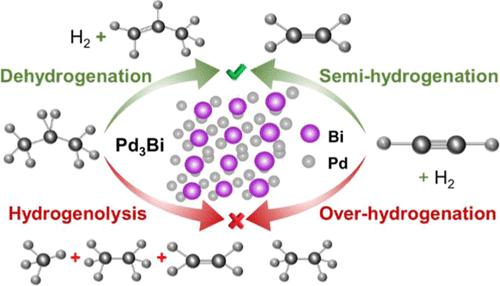当前位置:
X-MOL 学术
›
ACS Catal.
›
论文详情
Our official English website, www.x-mol.net, welcomes your
feedback! (Note: you will need to create a separate account there.)
Bismuth-Modulated Surface Structural Evolution of Pd3Bi Intermetallic Alloy Catalysts for Selective Propane Dehydrogenation and Acetylene Semihydrogenation
ACS Catalysis ( IF 11.3 ) Pub Date : 2022-08-11 , DOI: 10.1021/acscatal.2c00642 Wenqing Zhang 1 , Xiaoben Zhang 2, 3 , Jianyang Wang 4 , Arnab Ghosh 5 , Jie Zhu 4 , Nicole J. LiBretto 1 , Guanghui Zhang 4 , Abhaya K. Datye 5 , Wei Liu 2 , Jeffrey T. Miller 1
ACS Catalysis ( IF 11.3 ) Pub Date : 2022-08-11 , DOI: 10.1021/acscatal.2c00642 Wenqing Zhang 1 , Xiaoben Zhang 2, 3 , Jianyang Wang 4 , Arnab Ghosh 5 , Jie Zhu 4 , Nicole J. LiBretto 1 , Guanghui Zhang 4 , Abhaya K. Datye 5 , Wei Liu 2 , Jeffrey T. Miller 1
Affiliation

|
Atomic regulation of metal catalysts, especially of the active surface, is key to optimizing the catalytic performance. In this work, we tuned surface Pd coordination by varying bismuth loadings in the Pd–Bi alloy system, facilitating different catalytic performances for propane dehydrogenation (PDH) and acetylene semihydrogenation model reactions. In situ X-ray absorption spectroscopy, atom-resolved scanning transmission electron microscopy combined with elemental distribution analysis, infrared spectroscopy, and in situ X-ray photoelectron spectroscopy were employed to characterize the evolution of the surface and bulk structures in Pd–Bi catalysts with changing Bi composition. At low Bi loading, the catalyst nanoparticle (NP) surface was partially transformed into the Pd–Bi intermetallic compound (IMC). The partially alloyed surface has improved catalytic performance compared with Pd NPs. At slightly higher Bi loading, a Pd core–Pd3Bi shell structure was formed, which displayed significantly improved selectivity rate and stability. In the Pd3Bi IMC surface structure, the adjacent Pd atoms are sufficiently far apart to give catalytically isolated active sites, which significantly enhance the selectivity (>95%) to propylene in PDH and give a higher ethylene selectivity (80%) for acetylene semihydrogenation compared with Pd NPs. At higher Bi loading, a full Pd3Bi is formed; however, at even higher loading, an overcoating of excess BiOx leads to a loss in activity. This work demonstrates that in intermetallic alloy catalysts, the surface and bulk structures of the NPs are different with different promoter metal loadings. Importantly, the catalyst performance is not only determined by the alloy structure but also can be significantly affected by the properties of the noncatalytic oxide promoter.
中文翻译:

用于丙烷选择性脱氢和乙炔半氢化的 Pd3Bi 金属间合金催化剂的铋调制表面结构演变
金属催化剂,尤其是活性表面的原子调控是优化催化性能的关键。在这项工作中,我们通过改变 Pd-Bi 合金体系中的铋负载量来调整表面 Pd 配位,促进丙烷脱氢 (PDH) 和乙炔半加氢模型反应的不同催化性能。原位X 射线吸收光谱、原子分辨扫描透射电子显微镜结合元素分布分析、红外光谱和原位X 射线光电子能谱用于表征随着 Bi 成分变化的 Pd-Bi 催化剂的表面和整体结构的演变。在低 Bi 负载下,催化剂纳米颗粒 (NP) 表面部分转化为 Pd-Bi 金属间化合物 (IMC)。与 Pd NPs 相比,部分合金化的表面具有改善的催化性能。在稍高的Bi负载下,形成了Pd核-Pd 3 Bi壳结构,显示出显着提高的选择性和稳定性。在 Pd 3Bi IMC 表面结构,相邻的 Pd 原子相距足够远以产生催化分离的活性位点,与 Pd 相比,这显着提高了 PDH 中丙烯的选择性(>95%),并为乙炔半加氢提供了更高的乙烯选择性(80%) NP。在较高的 Bi 负载下,形成完整的 Pd 3 Bi;然而,在更高的负载下,过量的 BiO x的外涂层会导致活性损失。这项工作表明,在金属间合金催化剂中,NPs 的表面和整体结构随着助催化剂金属负载的不同而不同。重要的是,催化剂性能不仅取决于合金结构,而且还受到非催化氧化物促进剂性能的显着影响。
更新日期:2022-08-11
中文翻译:

用于丙烷选择性脱氢和乙炔半氢化的 Pd3Bi 金属间合金催化剂的铋调制表面结构演变
金属催化剂,尤其是活性表面的原子调控是优化催化性能的关键。在这项工作中,我们通过改变 Pd-Bi 合金体系中的铋负载量来调整表面 Pd 配位,促进丙烷脱氢 (PDH) 和乙炔半加氢模型反应的不同催化性能。原位X 射线吸收光谱、原子分辨扫描透射电子显微镜结合元素分布分析、红外光谱和原位X 射线光电子能谱用于表征随着 Bi 成分变化的 Pd-Bi 催化剂的表面和整体结构的演变。在低 Bi 负载下,催化剂纳米颗粒 (NP) 表面部分转化为 Pd-Bi 金属间化合物 (IMC)。与 Pd NPs 相比,部分合金化的表面具有改善的催化性能。在稍高的Bi负载下,形成了Pd核-Pd 3 Bi壳结构,显示出显着提高的选择性和稳定性。在 Pd 3Bi IMC 表面结构,相邻的 Pd 原子相距足够远以产生催化分离的活性位点,与 Pd 相比,这显着提高了 PDH 中丙烯的选择性(>95%),并为乙炔半加氢提供了更高的乙烯选择性(80%) NP。在较高的 Bi 负载下,形成完整的 Pd 3 Bi;然而,在更高的负载下,过量的 BiO x的外涂层会导致活性损失。这项工作表明,在金属间合金催化剂中,NPs 的表面和整体结构随着助催化剂金属负载的不同而不同。重要的是,催化剂性能不仅取决于合金结构,而且还受到非催化氧化物促进剂性能的显着影响。










































 京公网安备 11010802027423号
京公网安备 11010802027423号